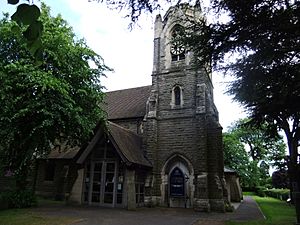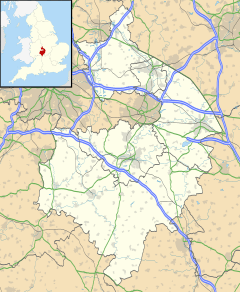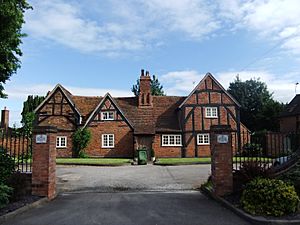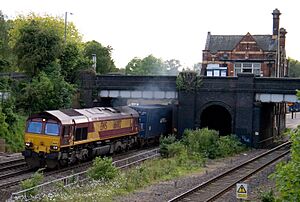Water Orton facts for kids
Quick facts for kids Water Orton |
|
|---|---|
 St Peters' and St Pauls' Church, Water Orton's parish church |
|
| Population | 3,487 (2021 Census) |
| OS grid reference | SP179927 |
| Civil parish |
|
| District |
|
| Shire county | |
| Region | |
| Country | England |
| Sovereign state | United Kingdom |
| Post town | BIRMINGHAM |
| Postcode district | B46 |
| Police | Warwickshire |
| Fire | Warwickshire |
| Ambulance | West Midlands |
| EU Parliament | West Midlands |
| UK Parliament |
|
Water Orton is a village in Warwickshire, England. It is located in the West Midlands area, close to the River Tame. The village is found between Castle Bromwich and Coleshill. It also borders the West Midlands county on three sides. In 2021, about 3,487 people lived there.
Contents
What's in a Name?
Water Orton was first written down in 1262 as Overton. This name means "farm by the bank or edge." People used this name for a long time. Later, in 1431, it was called Oreton.
In 1546, the name Water Ouerton appeared. Then, in 1605 and 1652, it was called Water Ouerton al. Water Orton. Experts now think Water Orton might have been mentioned in the old Domesday Book of 1086 as 'Wavre' (Over), along with Castle Bromwich.
Village History
The oldest part of Water Orton is around Old Church Road. This area became a special "conservation area" in 1983. This means it's protected because of its history. This old part of the village overlooks the River Tame. Here, people have found pieces of pottery from the 12th century. This shows that people lived here a very long time ago.
Many buildings in this old area are "listed buildings." This means they are important and protected. One is The Chestnuts, a house from the 1400s. It might have been the old manor house, where a lord or lady lived. Another is Wakefield House, a house built with wood frames from the 1600s.
Water Orton was once part of the larger parish of Aston. A parish is like a church district. For a long time, people from Water Orton went to church in Castle Bromwich. In 1346, they built their own small church, called a chapel. They got permission to have their own priest. But they were still connected to the main church in Aston until 1871.
The first chapel is no longer there. But the old graveyard on Old Church Road still exists. You can also see a stone village cross from 1347 there. The current church, St Peter and St Paul, was built in 1879. It used to have a tall spire, but it was taken down in 1987. This was because pollution had made it unsafe.
Before the 1840s, Water Orton was mostly a farming village. But this changed when the railways arrived. The first railway line connected Birmingham New Street to Derby. It passed through Water Orton. Later, another line was built. These railway lines go right through the middle of the village.
The Water Orton railway station you see today was built in 1908. It's the second station in the village. The railway brought more houses to Water Orton. People could now travel to Birmingham much faster than by road. This made Water Orton a good place for people who worked in Birmingham but wanted to live in the countryside.
The railway also brought the meat industry. There were large "stock yards" near the railway lines. Cattle were brought by train and kept in pens. Then, they were taken to Castle Bromwich to be prepared for meat. This meat was then sold to nearby villages.
Village Features
There is an old sandstone bridge over the River Tame. It is on the road to Minworth. This bridge is a "grade II listed" building and an "ancient monument." This means it's very important and protected. It was built in 1520 by Bishop John Vesey. It replaced an even older bridge that was in bad condition.
Learning in Water Orton
The village has its own school, Water Orton Primary School. It first opened in 1878. The school moved to a new building in 2019. This move happened because of the new High Speed 2 railway line, which was planned to be very close to the old school.
Getting Around
Water Orton is close to major motorways like the M6, M6 toll, and M42. The Water Orton railway station was built in 1842. It offers some train services to Birmingham New Street and Leicester.
The village also has bus services. The National Express West Midlands X13 bus goes to Birmingham and Chelmsley Wood. Since April 2022, the Diamond Bus service 76 also connects the village to Tamworth and Sutton Coldfield.
Famous People from Water Orton
- Lawrence - He started the indie band, Felt.
- Maurice Deebank - He also helped start the indie band, Felt.
See also
 In Spanish: Water Orton para niños
In Spanish: Water Orton para niños




